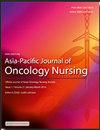食管癌术后口服摄入康复期的症状:网络分析
IF 2.8
3区 医学
Q1 NURSING
引用次数: 0
摘要
目的:食管切除术后患者在口腔摄入康复期间出现多种症状,但症状间的相互作用尚不清楚。本研究旨在确定症状群、核心症状及其关系,为有针对性的护理干预提供信息。方法在本横断面研究中,252名参与者完成了安德森症状评估量表和欧洲癌症研究与治疗组织生活质量问卷,特别是食管特异性模块(EORTC QLQ-OES18)。通过主成分分析(SPSS 26.0)得出症状聚类,并进行网络分析(R4.3.1)来探索症状的中心性和相互关联性。结果出现5组症状:反流症状、饮食改变、情绪低落症状、神经损伤症状和能量不足症状。焦虑(强度= 4.878,中间值= 20,亲密度= 0.263)和难以享受饮食(强度= 4.666,中间值= 28,亲密度= 0.258)被确定为核心症状,并且桥强度最高(焦虑:3.400;享受美食的困难:3.210)。出现这些症状的患者表现出更大的体重减轻(痛苦:2.60±2.52 vs 1.68±2.10 kg, P = 0.002;进食困难:2.42±2.56 vs. 1.65±2.00 kg, P = 0.009)。结论焦虑、不享受饮食既是核心症状,也是桥梁症状。未来针对这两种症状的干预措施可能能够减轻食管癌术后口服摄入康复期间的整体症状和体重减轻。本文章由计算机程序翻译,如有差异,请以英文原文为准。
Symptoms experience during the oral intake rehabilitation period following esophagectomy: A network analysis
Objective
Patients experience diverse symptoms during the oral intake rehabilitation period after esophagectomy, yet symptom interactions remain poorly understood. This study aimed to identify symptom clusters, core symptoms, and their relationships to inform targeted nursing interventions.
Methods
In this cross-sectional study, 252 participants completed the Anderson Symptom Assessment Scale and the European Organization for Research and Treatment of Cancer quality of life questionnaire, specifically the esophageal-specific module (EORTC QLQ-OES18). Symptom clusters were derived via Principal Component Analysis (SPSS 26.0), and a network analysis (R4.3.1) was conducted to explore symptom centrality and interconnectedness.
Results
Five symptom clusters emerged: reflux symptoms, unpleasant eating changes, low spirits symptoms, nerve damage symptoms, and energy deficiency symptoms. Distress (strength = 4.878, betweenness = 20, closeness = 0.263) and trouble enjoying meals (strength = 4.666, betweenness = 28, closeness = 0.258) were identified as core symptoms and with the highest bridge strength (distress: 3.400; trouble enjoying meals: 3.210). Patients experiencing these symptoms exhibited significantly greater weight loss (distress: 2.60 ± 2.52 vs. 1.68 ± 2.10 kg, P = 0.002; trouble enjoying meals:2.42 ± 2.56 vs. 1.65 ± 2.00 kg, P = 0.009).
Conclusions
Distress and trouble enjoying meals are not only core symptoms but also bridge symptoms. Future interventions targeting these two symptoms may be able to alleviate the overall symptoms and reduce weight loss during the oral intake rehabilitation period following esophagectomy.
求助全文
通过发布文献求助,成功后即可免费获取论文全文。
去求助
来源期刊

Asia-Pacific Journal of Oncology Nursing
Multiple-
CiteScore
2.80
自引率
11.10%
发文量
136
审稿时长
31 days
 求助内容:
求助内容: 应助结果提醒方式:
应助结果提醒方式:


